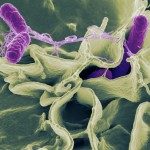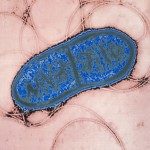BioRxiv (2019) 716407. doi:10.1101/716407.
Bacterial shape is physically determined by the peptidoglycan cell wall. The cell-wall-synthesis machinery responsible for rod shape in Escherichia coli is the processive 9Rod complex9. Previously, cytoplasmic MreB filaments were thought to govern formation and localization of Rod complexes based on local cell-envelope curvature. However, using single-particle tracking of the transpeptidase PBP2, we found strong evidence that PBP2 initiates new Rod complexes by binding to a substrate different from MreB or any known Rod-complex component. This substrate is likely the cell wall. Consistently, we found only weak correlations between MreB and envelope curvature in the cylindrical part of cells. Residual correlations do not require any curvature-based Rod-complex initiation but can be attributed to persistent rotational motion. Therefore, local cell-wall architecture likely provides the cue for PBP2 binding and subsequent Rod-complex initiation. We also found that PBP2 has a limiting role for Rod-complex activity, thus supporting its central role.


